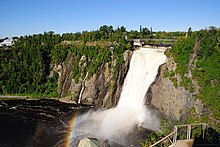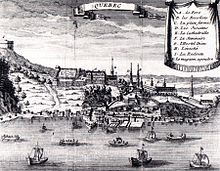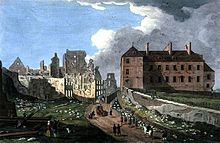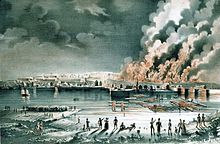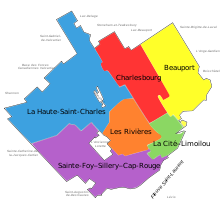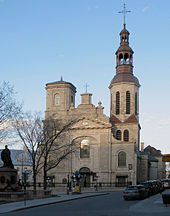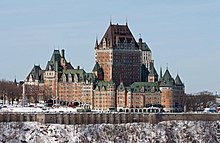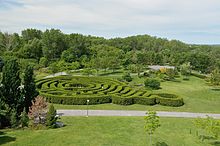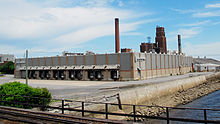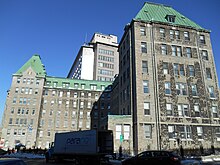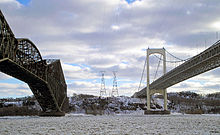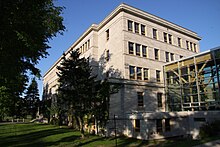Quebec City
| Quebec | ||
|---|---|---|
| Nickname : la Vieille Capitale ("the old capital") | ||
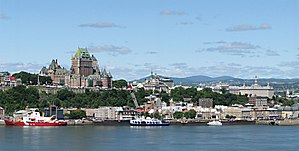 Québec city center with Château Frontenac |
||
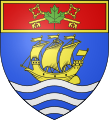 coat of arms |
 flag |
|
|
Motto : Don de Dieu feray valoir ("I will use God's gift well") |
||
| Location in Quebec | ||
|
|
||
| State : |
|
|
| Province : | Quebec | |
| Administrative region : | Capitale-Nationale | |
| MRC or equivalent : | Quebec agglomeration | |
| Coordinates : | 46 ° 49 ′ N , 71 ° 13 ′ W | |
| Height : | 30 m | |
| Area : | 454.1 km² | |
|
Inhabitants : - Metropolitan Area : |
531.902 (as of 2016) 812.205 (as of 2017) |
|
| Population density : | 1,171.3 inhabitants / km² | |
| Time zone : | Eastern Time ( UTC − 5 ) | |
| Municipality number: | 23027 | |
| Postal code : | G1A-G2N | |
| Area code : | +1 418 | |
| Foundation : | 1608 | |
| Mayor : | Regis Labeaume | |
| Website : | www.ville.quebec.qc.ca | |
 Located in the Québec agglomeration |
||
Québec ( French [ kebɛk ] ) or Quebec ( English [ kɨˈbɛk ] ), also known as Ville de Québec or Quebec City for better differentiation , is a city in eastern Canada . The capital of the province of Québec of the same name is located on the north bank of the Saint Lawrence River , at the mouth of the Rivière Saint-Charles , which rises in the Laurentine Mountains, and in front of the beginning of the Saint Lawrence estuary . Distinctive geographical features are the striking narrowing of the river, which gave the city its name, as well as the high plateau of the Colline de Québec , on which the city center is located, towering around a hundred meters above the river .
The original inhabitants of the region were Saint Lawrence Iroquois who lived in the village of Stadacona . In 1543 the first French colonization attempt led by Jacques Cartier failed . On July 3, 1608, the navigator Samuel de Champlain founded a trading post from which the later city developed. Three years after being conquered by English adventurers, Québec returned to French possession in 1632. Further British and British attempts at conquest in 1690 and 1711 failed. In 1759 the British finally succeeded in taking the city for good after a two and a half month long siege and the battle on the Plains of Abraham . In 1867 Québec became a provincial capital in the new Canadian state. In the second half of the 19th century, the city lost its status as a leading economic center to Montreal and stagnated for several decades. During the 20th century Québec became the undisputed center of the east of the province.
Architecturally, Québec is considered the most European city in North America, due to the well-preserved old town with numerous buildings predominantly French in character, which date back to the first half of the 17th century. The upper part of the old town is surrounded by city walls, which are complemented by a citadel . Québec is now the only fortified city in America north of Mexico . In 1985, UNESCO declared the old town and the fortifications a world heritage site .
With a population of 531,902 (2016), Québec is the second largest city in the province and the eleventh largest in Canada. It achieved this status in 2002 when the population tripled through the incorporation of several suburbs. 93.8% of the population are French-speaking . The metropolitan region Communauté métropolitaine de Québec , which includes the city of Lévis south of the Saint Lawrence River , has a population of 812,205 (2017). The service sector is economically dominant , with public administration being represented above average. Tourism is also of great importance. The industry is geared towards research-intensive cutting - edge technology , the woodworking industry, which used to dominate, now only plays a marginal role.
geography
location
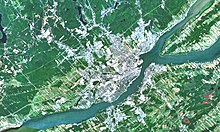
The city of Québec is located in the south of the province of Québec named after it , about 120 kilometers northwest of the border with the US state Maine . Montreal is 233 kilometers away in the southwest, the federal capital Ottawa 378 km in a west-southwest direction. It is 498 km south to Boston and 644 km east-southeast to Halifax .
Waters
Québec is located on the north bank of the Saint Lawrence River , the third largest river in North America (measured by its discharge). The river is two and a half to three kilometers wide above the city and narrows in the area of the city center to just over a kilometer. It then divides into two arms that surround the Île d'Orléans . After this island, the Saint Lawrence estuary begins, which is over 350 km long and up to 60 km wide . Since the channel greatly increases the flow speed and the tides are still clearly noticeable due to the small difference in altitude to the Atlantic Ocean (1.8 to 3.1 m difference between ebb and flow), the Quebec bottleneck is a demanding place for shipping.
The most important tributary is the Rivière Saint-Charles, which lies entirely within the urban area . It rises in Lac Saint-Charles on the northern outskirts of the city, stretches - especially in the upper course, strongly meandering - in a south-easterly direction and flows into the St. Lawrence River after 35 kilometers. Its catchment area, which includes several other rivers, is the most densely populated in the province of Québec. A small part of the urban area in the extreme northwest belongs to the catchment area of the Rivière Jacques-Cartier . The lower reaches of the Rivière Montmorency forms the eastern city limits, the southwest of the city is drained by the Rivière du Cap Rouge and the Lac Saint-Augustin . In the 454.1 km² urban area there are a total of 230 still waters and 695 km of flowing waters .
Topography and geology
In the urban area, three geological regions almost meet and are only a few kilometers apart. The Colline de Québec rises along the north bank of the Saint Lawrence River . This high plateau 13 kilometers long and one to four kilometers wide was of decisive importance for the formation and development of the city. It stretches from Cap Rouge in the west to Cap Diamant near the mouth of the Rivière Saint-Charles. The plateau, which reaches a height of 110 meters (around a hundred meters above the surrounding area), is bordered by rocky slopes that slope steeply, especially towards the river. The Colline de Québec is one of the few branches of the Appalachian Mountains north of the river . The base is made of sandstone and mudstone , and slate can be found on the ledges .
The broad, flat valley of the Rivière Saint-Charles, together with the adjoining terraces of Charlesbourg and Beauport, is part of the Saint Lawrence Lowland. Sediment layers up to 60 meters thick have been deposited there - mainly sand and gravel , and occasionally peat . About 11,500 to 9,800 years ago, in the final phase of the last glacial period (known as the Wisconsin Glaciation in North America ), the lowlands were below sea level in the Champlain Sea . This shallow inlet of the Atlantic Ocean gradually disappeared due to the postglacial land uplift . With the advancing uplift of the land, during which large amounts of sediment were deposited, islands initially formed (including the Colline de Québec). Around 9,000 years ago, a freshwater lake replaced the Champlain Sea, Lac Lampsilis. This lasted for about 2300 years and gave way to the forerunner of the St. Lawrence River. For around 3000 years, the current has roughly matched its current shape.
In the northern third of the city area are the foothills of the Laurentine Mountains . They are part of the Canadian Shield , a huge area of very old igneous rock . The Laurentian Mountains are heavily eroded remnants of Grenville- orogeny (orogeny), who, during the Mesoproterozoikums occurred before around 1 to 1.6 billion years ago. Anorthosite is predominant , with feldspar running through it. This dark rock is covered by gravel and sand deposits, a legacy of glaciations. The highest point in the city is the 485 meter high Mont Bélair . A distinctive stratification characterizes the transition between the Canadian Shield and the Saint Lawrence Lowlands. The Rivière Saint-Charles flows over the 28 meter high waterfall Kabir Kouba (Chute Kabir Kouba) . In the far east, where the strata almost reaches the Saint Lawrence River, the Rivière Montmorency overcomes the 83 meter high Montmorency Falls (Chute Montmorency) , the highest waterfall in the province.
Neighboring communities
Neighboring municipalities are Saint-Augustin-de-Desmaures and Sainte-Catherine-de-la-Jacques-Cartier in the west, Shannon and Saint-Gabriel-de-Valcartier in the north-west, Stoneham-et-Tewkesbury , Lac-Delage and Lac-Beauport in the North and Sainte-Brigitte-de-Laval and Boischatel in the northeast. On the opposite side of the Saint Lawrence River, to the south, is the city of Lévis . There are three enclaves within the city limits : the city of L'Ancienne-Lorette , the just four hectare parish of Notre-Dame-des-Anges and Wendake (an Indian reserve of the Wyandot ).
climate
Québec has a boreal , humid continental climate , which corresponds to the effective climate classification Dfb. Due to the proximity to the ocean, the maritime climate also has a certain influence. Summers are short and hot and humid with an average maximum temperature of 25 ° C. On individual days, temperatures can rise well over 30 degrees Celsius, with a relatively high level of humidity throughout. Winter is characterized by very cold, snowy and windy weather, with prolonged periods of frost below −20 ° C. Spring and autumn are mild, but temperature fluctuations can occur. The annual rainfall is around 1190 mm. In the months of November to April, an average of about 303 cm of snow falls , with the snow cover being more than 20 cm thick on 110 days. The duration of sunshine is 1916 hours a year. The lowest temperature ever recorded was -36.1 ° C on February 2, 1962, the highest 35.6 ° C on July 17, 1953. The greatest amount of rain in one day was 81.2 mm on September 14, 1979, the greatest 52 cm of fresh snow on December 15, 2003. The St. Lawrence River usually freezes over from mid-December to the end of March (in extreme cases from the end of November to the beginning of May), which is why river navigation with icebreakers has to be maintained.
| Quebec | ||||||||||||||||||||||||||||||||||||||||||||||||
|---|---|---|---|---|---|---|---|---|---|---|---|---|---|---|---|---|---|---|---|---|---|---|---|---|---|---|---|---|---|---|---|---|---|---|---|---|---|---|---|---|---|---|---|---|---|---|---|---|
| Climate diagram | ||||||||||||||||||||||||||||||||||||||||||||||||
| ||||||||||||||||||||||||||||||||||||||||||||||||
|
Average monthly temperatures and rainfall for Québec
|
||||||||||||||||||||||||||||||||||||||||||||||||||||||||||||||||||||||||||||||||||||||||||||||||||||||||||||||||||||||||||||||||||||||||||||||||||||||||||||||||||||||||||||||||||||
fauna and Flora

Slightly more than 35% of the urban area is forested , with the forests mostly covering the northern part located on the Canadian Shield. Before the European settlement there were only a few unforested areas. The original vegetation differed according to the nature of the soil and climatic conditions, usually with deciduous forest in the south and coniferous forest in the north. On the Colline de Québec, sugar maples predominated, alongside linden , beech and elm trees . Red maples were found in lower, more humid areas, red oak and Weymouth pine in dry locations . Birch forests in particular stretched along the Rivière Saint-Charles , loosened up by various other deciduous trees. In the north, pine forests still predominate today, with a few yellow birch trees . There are a total of 30 nature and landscape protection areas in the urban area .
Since the forests often directly border the settlements, numerous animal species have adapted to life in urban surroundings. Among the most widely used mammalian species include Grauhörnchen , red squirrel , eastern chipmunk , Streifenskunks , Baumstachler , muskrat , raccoon , mink , woodchucks , red foxes , snowshoe rabbits , elk , white-tailed deer and various New world . Occasionally wolves and coyotes as well as black bears are also spotted. The herpetofauna , i.e. the totality of amphibians and reptiles , has a low biodiversity and is strongly endangered by urbanization, agriculture and forestry. In total, only 20 different species are counted. On the other hand, the avifauna (totality of bird species ) is characterized by a great diversity due to the different habitats. Although there is no systematic inventory, at least 324 species have been identified so far. The St. Lawrence River in particular has a diverse ichthyofauna : There are up to 71 species of fish , with cod , perch , pike and sucker carp being the most common. The diversity in the tributaries is significantly lower.
history
Origin of name
The city name goes back to the narrowing of the river between Québec and the opposite Lévis . In the Algonquin language , the word Kebec stands for "where the river narrows". The Algonquians themselves have always referred to the city as Kephek , and the Mi'kmaq , who live further east, as Gepeg , whereby the latter can also be translated as “bottleneck”. According to a less popular theory, kepek was said to have been an invitation from the Innu , who lived north of this area, to ask Samuel de Champlain to get off his ship.
The name Québec quickly caught on, but over the years there have been two serious suggestions for another city name. Champlain himself proposed in 1618, the city in honor of the French King Louis XIII. To name Ludovica . After the Canadian Confederation was founded in 1867, the problem was that the new province of Québec had the same name as the city. To avoid confusion, the city should be named Stadacona (after an earlier settlement of the indigenous people). Corresponding entries were unsuccessful.
In older documents several different spellings can be found: Quebecq (1601), Kébec (1609), Quebec (1613). The names of the city dwellers also took different forms: Kébécois (1935), Québeccois (1835), Quebecois (1754), Québécois (1775), Québecquois (1825), Québécuois (1910), Quebequois (1754) and also stadaconia . The variant from 1775 prevailed. In French, a distinction is made between town and province by adding the definite article le in front of the latter .
Early history and discovery
The oldest traces of human settlement can be found in the area of Place Royale in the lower town. Stone tools discovered there are around 5000 years old and thus come from the Archaic and early Woodland periods . The tools were manufactured by the local hunters, gatherers and fishermen from locally available rock types. Also in the archaic period, around 4000 years ago, people settled on the east bank of Lac Saint-Charles .
Pottery from the Woodland period, which was made around 2,400 to 450 years ago, was found under Place Royale. Around AD 500, the regions of Québec and Montreal began developing different styles of pottery, which is believed to be indicative of groups or tribes with different identities. Findings of pipe bowls (and thus the production of tobacco) point in a similar direction, namely ethnic differentiation and increasing agriculture. These pipe bowls were rare before 700, but were common and widespread later. The north-eastern part of what will later become the Upper Town was probably inhabited from the middle of the 14th to the middle of the 16th century.

The French navigator Jacques Cartier was commissioned by King François I in 1534 to find a north-west passage to Asia. His first expedition took him to the island of Anticosti , but he did not advance further into the estuary of the St. Lawrence River. With a second expedition he went up the river in 1535, reached today's urban area on September 7th and discovered the village of Stadacona , a settlement of the Saint Lawrence Iroquois with around 500 inhabitants , on the lower reaches of the Rivière Saint-Charles . After exploring upstream to the Île de Montréal, Cartier wintered in Stadacona. When he returned to Europe in May 1535, he had the Iroquois ruler Donnacona kidnapped, who died four years later in France.
In 1541 the king commissioned the courtier Jean-François de La Rocque de Roberval to set up a colony. La Roque entrusted Cartier with the execution of the plan. His third expedition should not only create a permanent French presence in the New World , but also find the legendary Kingdom of Saguenay . About 350 colonists arrived in Stadacona in August 1541. Due to hostilities, they drove a few kilometers upstream and founded the Charlesbourg-Royal settlement on Cap Rouge . Raids by the St. Lawrence Iroquois, a severe winter and scurvy troubled the colonists. In June 1542 they returned to France disaffected. A second group of 200 settlers under La Roques' command had set out for Charlesbourg-Royal two months earlier and arrived there in July. The problems continued unabated, which is why the settlement was finally abandoned in the spring of 1543.
French colonial times
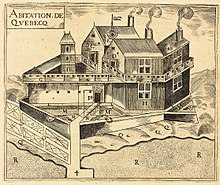
In 1603, Samuel de Champlain undertook a voyage of discovery that followed Cartier's footsteps and took him to the Stadacona region. The village could no longer be found and the St. Lawrence Iroquois had disappeared without a trace. Apart from the nomadic Algonquians and Innu, the Saint Lawrence lowlands were largely uninhabited. Conflicts with neighboring Iroquois tribes , the effects of epidemics brought in by Europeans, such as Basque fishermen, or migration towards the Great Lakes are blamed for the disappearance of the original population . The former was considered the most likely, but the underlying processes remain unclear. Seven distinct groups along the St. Lawrence River can be identified archaeologically. The group around Québec was active in long-distance trade, which brought them into the possession of products from the hunters of beluga whales and seals on the Atlantic coast. In addition, the Québec Iroquois differed from the rest in that they did not develop a sedentary horticultural culture, but instead used the estuary in seasonal migrations. They developed a common way of life with Algonquin groups.
Also in 1603, Pierre Dugua de Mons was granted the trade monopoly in New France by King Henri IV , with the fur trade in particular promising large profits. De Monts lost his monopoly in 1607 due to complaints from competing traders, but regained it a year later after promising to set up a trading post on the Saint Lawrence River. The city of Québec was founded on July 3, 1608, when Champlain landed at the Cap Diamant in De Monts' order and began to build the Habitation de Québec together with craftsmen and workers at today's Place Royale . This "dwelling" served as a dwelling, fort and trading post. Only eight out of 28 expedition members, including Champlain, survived the first winter. Gradually the situation stabilized and a small influx of colonists began. In 1620, the Château Saint-Louis was the first building on the high plateau.
In 1627, under the chairmanship of Cardinal Richelieu, the Compagnie de la Nouvelle France was founded, a state-privileged trading company with an unlimited fur trade monopoly. Before their partners could begin to bring 4,000 settlers to New France in accordance with the contract, France and England had gone to war against each other as part of the Thirty Years' War . An expedition led by the adventurer David Kirke captured Québec on July 19, 1629. With the exception of the family of the first settler Louis Hébert , the French residents left the settlement; in 1627 there were only 85 people, exclusively men. The conquest happened three months after a peace agreement was signed, which is why France insisted on a return. This was finally agreed in 1632 in the Treaty of Saint-Germain-en-Laye . The Catholicism practiced early from great impact on society. In 1615 the first Franciscan missionaries came to Québec; The Jesuits followed in 1625, the Ursulines and the Augustinians in 1639 . While the social elite and religious communities settled in the upper town, traders, sailors and craftsmen populated the lower town.
The company had only moderate success in the economic development and colonization of New France, and the territory was poorly secured militarily. King Louis XIV declared the colony a province in 1663 and placed it directly under the Crown. He made Québec the capital and changed the administration. At that time the city had just over 500 inhabitants (almost a quarter of them clergy), and there was a great imbalance between the sexes. In order to stimulate population growth, the king financed the passage and dowry of young, single women from poor backgrounds. Between 1663 and 1673, around 800 " daughters of the king " (filles du Roi) came to Québec in this way . In 1665 the king dispatched 1,200 men from the Carignan Salières regiment to eliminate the threat of raids by the Iroquois during the Beaver Wars . After the campaign was over, over a third of the soldiers settled here. Most of the immigrants came from the north and west of France, more precisely from the provinces of Normandy , Île-de-France , Aunis , Poitou , Perche and Saintonge .
Trade was restricted by law to France and other French colonies. New France therefore had a consistently negative trade balance . For decades this resulted in a chronic lack of cash, so that from 1685 playing cards were temporarily in circulation as a substitute currency . In 1688 the King William's War broke out, in which the French and the Wabanaki Confederation fought against the English and Iroquois. In response to encroachments in New England , in the fall of 1690 an English fleet under the command of William Phips sailed for Québec to take the city. After Governor Louis de Buade de Frontenac rejected the call to surrender on October 16, French troops and militias succeeded in routing the English at the Battle of Québec after eight days. In the next of the " French and Indian Wars ", the Queen Anne's War , another fleet tried to conquer the city. The British Québec expedition ended in disaster on August 22, 1711, when eight ships capsized in the Saint Lawrence River; 890 soldiers and sailors were killed. From 1693 onwards, a system of walls and ramparts was built around the city , but in 1721 the government decided against expanding the partially isolated fortifications into an actual fortress city. The destruction of Louisbourg during the King George's War in 1745 caused great concern among the population. The governor immediately ordered the completion of the fortifications. The Chemin du Roy , completed in 1737, enabled a more intensive exchange of goods with Montreal , since the St. Lawrence River, which freezes over in winter, was no longer an obstacle.
British rule
Five years after the outbreak of the Seven Years' War in North America , a British force with 168 ships sailed up the St. Lawrence River in June 1759. The siege of Québec began on June 26 and lasted over two and a half months. The French were able to repel their first attempt at storming on July 31 at the Battle of Beauport . The decisive battle on the Plains of Abraham on September 13th ended in a British victory and made it possible to close the siege ring, whereupon the French garrison surrendered five days later. Both commanders-in-chief, James Wolfe and Louis-Joseph de Montcalm , did not survive the battle. Seven months later, French troops from Montreal tried to retake Québec. Although they won the Battle of Sainte-Foy on April 28, 1760 , they were unable to take the city. They retired to Montreal, where they eventually had to bow to British superiority. With the Peace of Paris in 1763 , New France finally passed into British possession. Québec became the capital of the new British province of Québec and the main administrative center of British North America .
Despite heavy damage from the artillery fire, the city quickly recovered from the consequences of the war. The British repaired the fortifications for fear of revolts and a reconquest by France. For financial reasons, they initially decided not to expand. The Quebec Act , which came into force in 1774, guaranteed freedom of religion and restored French private law. In this way, the British secured the loyalty of the large landowners and the clergy. This law was one of the Intolerable Acts ("intolerable laws") that increased the unrest in the southern Thirteen Colonies and there contributed to the outbreak of the American War of Independence in the following year . In the first months of the conflict, tried the Continental Army , with a foray to the north to drive the British from the province of Quebec and the French-Canadian to win for the revolution. At the Battle of Québec on December 31, 1775, American troops led by Richard Montgomery and Benedict Arnold invaded the lower city, but were repulsed. They broke off the subsequent siege in May 1776 without any result.
Even after the British conquest, Québec remained an important trading city, although many French wholesalers left the city. They were increasingly replaced by the British, who benefited from a much larger trade network. They took control of the fur trade, fishing, shipbuilding and troop supply, while the French Canadians were pushed into the intermediate and retail trade. The timber industry initially played a minor role, as Great Britain covered its timber needs through imports from the Baltic Sea region . In 1806 the situation changed abruptly when Napoleon Bonaparte imposed the continental block. A decade-long boom set in, which, thanks to advantageous customs tariffs, continued unabated even after the end of the coalition wars. Most of the timber exported from Québec came from the Outaouais region and was transported here by raftsmen . For a time Québec was the third largest port in North America after New York and New Orleans . The export of wood also stimulated shipbuilding: at their peak around 1860, 28 shipyards were in operation that built sailing ships of all kinds. There were also numerous suppliers such as sailmakers and rope makers.
Between 1786 and 1812 the fortifications were strengthened again. a. with four Martello towers . The Citadel of Québec was built between 1820 and 1832 as the last and most important element . After its completion, the military claimed around a quarter of the city's area, the garrison was between 1,000 and 1,500 men strong. In the middle of the 19th century, the facilities were perceived as disruptive to the expansion of the city, especially since they were now considered technically obsolete. In the age of Romanticism , however, it was precisely the medieval-looking urban complex embedded in the surrounding natural beauty that attracted numerous travelers from Europe and the USA from the 1820s. In 1842, Charles Dickens described Québec in his Notes from America as "the Gibraltar of America". In contrast, there were the hardships of the residents. The numerous immigrants passing through brought repeated epidemics, in 1832 alone 3,292 people died of cholera . Inadequate building regulations in the suburbs favored major fires: on May 28, 1845 around 1,600 houses were destroyed in Faubourg Saint-Roch, and a month later another 1,300 in Faubourg Saint-Jean; more than 20,000 people were temporarily homeless.
During the French colonial era there was no independent city administration, administration was carried out directly by the colonial authorities. After the conquest, the city was under military administration for five years. From 1764, justices of the peace appointed by the governor were responsible for urban affairs. Although they were able to expand their skills over time, this simple administrative structure was soon insufficient for the rapidly growing city and there were frequent complaints. Finally, in 1833, Québec received a charter and an elected mayor. The governor temporarily repealed the charter three years later and reinstated it in 1840. From 1791 Québec was the capital of the British colony of Lower Canada . In the province of Canada , founded in 1841 , the capitals changed several times; Québec held this status from 1852 to 1856 and from 1859 to 1866.
Canadian provincial capital

In October 1864, the Quebec Conference took place, at which delegates from several colonies negotiated the future of British North America. They agreed to found the Canadian Confederation . From July 1, 1867, Québec was the capital of the province of the same name within the new Canadian state. The parliaments of Lower Canada and the Province of Canada had once met in the former bishop's palace until it burned down in 1854. The building that was built as a replacement did not meet the requirements, as it was also used as a post office. This is why the prestigious Hôtel du Parlement was built between 1877 and 1886 . Another important event was the withdrawal of the British garrison in 1871. Several city gates had previously been demolished to improve the flow of traffic. A committee around Governor General Lord Dufferin successfully campaigned for the preservation of the historically significant city walls and the reconstruction of two gates. The last major fire occurred in the Faubourg Saint-Sauveur in 1889 and destroyed around 500 houses. In the same year, boulders fell from Cap Diamant on the lower town; the Québec landslide killed over 40 people.
Compared to Montreal, which developed into Canada's economic metropolis, Québec quickly fell behind from the middle of the 19th century. There were various reasons for the decades of stagnation. The export of unprocessed raw wood decreased in favor of sawn timber produced elsewhere . The trade flows increasingly shifted towards the USA and western Canada , which favored cities like Montreal or Toronto . Technological progress caused the local shipbuilding industry to collapse completely in the 1870s: wooden sailing ships were no longer in demand and were replaced by ships with metal hulls. The port was also no longer competitive, as the dredging of a fairway in the Saint Lawrence River allowed ocean-going ships to sail past Québec to Montreal. The connection to the railway network was a long time coming. The Grand Trunk Railway , which opened in 1855, ran along the south bank, so that goods and passengers had to be laboriously transferred to and from Lévis by ferry . Only on February 11, 1879 was a route opened along the north bank of the Saint Lawrence River to Québec. The city had to be content with developing into a regional center for the east of the province.

The upswing began again at the turn of the 20th century. This development was favored on the one hand by several incorporations, which gave the city space for expansion. On the other hand, new industries with thousands of jobs had settled. These included u. a. the shoe industry , the textile and clothing industry , the tobacco industry , the paper industry , breweries and the manufacture of ammunition . The largest employer was the underwear manufacturer Dominion Corset with over 1000 employees. The railway network was oriented towards the northern hinterland, a direct connection to the sales markets in the USA was still missing. In 1903 construction began on the Québec Bridge over the Saint Lawrence River. The project financed by the federal government was under a bad star. Due to serious planning errors, the almost completed bridge collapsed completely in 1907, killing 76 workers. An assembly error led to the collapse of the central section in 1916 and killed 13 people. The bridge could not be opened for rail traffic until 1919, and ten years later for road traffic.
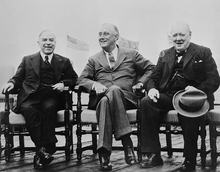
A new landmark in Québec was the Château Frontenac . This 1893 opened railway hotel of the Canadian Pacific Railway was instrumental in that, the city developed into a major tourist destination. Shortly after the outbreak of World War I , the Valcartier military base for 25,000 recruits was set up near the city in September 1914 . During a demonstration against the introduction of compulsory military service , which was controversial among Francophones , four people died on April 1, 1918 when soldiers shot into the crowd. In the city of Québec alone, 500 people died of the Spanish flu after the end of the war . The city administration was emphatically progressive in the 1920s and had numerous buildings demolished to make room for wider streets and modern new buildings. This approach was particularly evident when the Price Brothers paper company was allowed to build its headquarters in the middle of the old town between 1929 and 1931, the Édifice Price . There was political resistance to the threat to the architectural heritage, which gradually led to a change of heart.
The global economic crisis that began in 1929 hit industry hard, and the city administration reacted to the steep rise in unemployment with job creation measures. The situation only eased at the beginning of the Second World War , when arms production caused a surge in employment. In August 1943, the Quadrant Conference took place in Québec . William Lyon Mackenzie King and Winston Churchill , the Prime Ministers of Great Britain and Canada, and US President Franklin D. Roosevelt advised a. a. on the surrender of Italy and the planning for Operation Overlord . In September 1944 they met for the Second Québec Conference . The FAO was founded in Quebec in October 1945 . The mayor then had the idea that his city should apply for the headquarters of the United Nations - an ultimately unsuccessful undertaking.
Development into a modern metropolis
In the decades after the Second World War, the capital region experienced a rapid upswing, caused by the baby boom and a final surge in industrialization. The core city grew only slowly due to a lack of expansion opportunities and even had declining population numbers from the 1970s, while the previously rural suburban communities experienced rapid suburbanization . The significant expansion of the settlement area within a few years resulted in a high rate of automobiles. Between 1960 and 1976 a dense network of city motorways was built. At the end of the 1960s, city planners assumed that the Québec agglomeration would have a million inhabitants at the turn of the millennium and that a motorway tunnel under the old town would be essential to handle the additional traffic volume. After nearly a hundred meters had been drilled, the project was stopped in 1976 for financial reasons. Unused access ramps stood on the northern slope of the Colline de Québec for three decades until they were demolished in 2007. The Université Laval moved from the city center to a spacious campus in the suburb of Sainte-Foy. The retail trade increasingly shifted to large shopping centers.
A fundamental social change took place during the silent revolution of the 1960s. The Quebec provincial government secularized the education and health services that had previously been controlled by the Roman Catholic Church. In addition, several branches of the economy were nationalized. The numerous new areas of responsibility of the state led to a marked increase in the number of civil servants. As there was a lack of suitable premises, a new representative government district was created. Due to its exposed location near the highest point of the Colline de Québec, it symbolized the new self-image of the state. The de-industrialization and government austerity measures that stopped the growth of the public administration in the 1980s, called for a reorientation towards the knowledge economy. In April 2001 Québec hosted the third America Summit , the main theme of which was a planned American free trade area . Over 20,000 critics of globalization protested against the summit for days and tried to break through the three-kilometer security fence around the conference venue in the old town. In an investigation report two years later, the police were accused of using excessive force against the demonstrators.
Incorporations
Until the end of the 19th century, the urban area was limited to the old town and the immediately adjacent suburbs. Saint-Sauveur was incorporated as the first municipality in 1889. It was followed by Saint-Malo (1908), Limoilou (1909) and Montcalm (1913). Québec thus comprised an area that roughly corresponds to today's central district of La Cité-Limoilou . It took more than five decades until the next expansion. In 1970 Duberger and Les Saules were incorporated. Neufchâtel was added in 1971 and Charlesbourg-Ouest in 1973. These communes roughly correspond to the urban district of Les Rivières .
In 2001 the provincial government led by the Parti Québécois decided on numerous parish mergers; for example, the provincial capital should be merged with twelve suburbs. Despite strong political resistance, the government ordered the merger of Québec with Beauport , Cap-Rouge , Charlesbourg , L'Ancienne-Lorette , Lac-Saint-Charles , Loretteville , Saint-Augustin-de-Desmaures , and Saint-Émile on January 1, 2002 , Sainte-Foy , Sillery , Val-Bélair and Vanier . In the provincial elections in April 2003, the Parti libéral du Québec won . One of their election promises was to postpone the mergers to a referendum. But the new government set conditions that were difficult to meet. First, a tenth of all registered voters had to sign a petition to get a vote. Second, at least 35% of all registered voters had to agree (a simple majority was therefore not enough for the split). Referendums were held in all former municipalities on July 20, 2004. Six agreed to secede from Québec, but only L'Ancienne-Lorette and Saint-Augustin-de-Desmaures achieved the necessary quorum . These congregations were newly established on January 1, 2006, but had to cede some of their previous competencies to the communal association.
population
Population development
On May 10, 2011, Statistics Canada determined the following population figures: The city of Québec had 516,622 inhabitants, the agglomeration of Québec (city of Québec with L'Ancienne-Lorette , Notre-Dame-des-Anges and Saint-Augustin-de-Desmaures ) 551,902 inhabitants and the metropolitan area Communauté métropolitaine de Québec 765,706 inhabitants. This makes Québec the second most populous city in the province after Montreal and eleventh place in Canada.
The following table shows the population development according to the Canadian censuses, supplemented by censuses during the French and British colonial times. A distinction is made between today's urban area and the urban area before the municipal mergers of 2002. The number of inhabitants rose continuously until the 1870s, then flattened out significantly for three decades. Another boost followed until the middle of the 20th century, whereupon growth increasingly shifted to the suburbs that were still independent at the time. In the core city, the population decreased in the 1970s and then stagnated. The mergers eventually tripled.
| year | 1681 | 1739 | 1805 | 1844 | 1871 | 1901 | 1931 | 1951 | 1961 | 1971 | 1981 | 1991 | 2001 | 2011 | 2016 |
| historical urban area | 1,345 | 4,603 | 8,968 | 32,876 | 59,699 | 68,840 | 130,594 | 164.016 | 171,979 | 186.088 | 166,474 | 167,517 | 169.076 | - | - |
| today's urban area | - | - | - | - | 76,593 | 88,615 | 168,249 | 245,742 | 321.917 | 408,440 | 434.980 | 461.894 | 476.330 | 516,622 | 531.902 |
languages
The most widely spoken language in the city has always been French . After the end of French rule in 1759, English quickly gained influence: on the one hand because of Québec's importance as the administrative center of British North America , on the other hand because of the city's role as the most important contact point for European immigrants, often British. Significant waves of immigration from the British Isles (especially Ireland ) began after the coalition wars, in 1861 almost half of the city's population was English-speaking. A decade later that percentage had dropped to a third as Anglophones began to migrate to other parts of Canada. It continued to decline as Montreal became the country's economic capital. In 1971 only 6% of the population were English speakers.
At the 2011 census, the proportion of residents with a French mother tongue was 93.8%, the proportion of English was still 1.4%, while 0.5% gave both French and English. 4.3% were “ allophones ”, ie people whose mother tongue is neither of the two official Canadian languages. The most important languages of the immigrants were Spanish (1.0%) and Arabic (0.6%). 37.3% of the population spoke both of these official languages; only French was spoken by 62.1%. From a linguistic point of view, the city of Québec is much more homogeneous than Montreal, where native French speakers make up just over half of the population and allophones make up a third of the population.
Religions
The vast majority of the population is Roman Catholic . In 2001, 89.0% said they belonged to this denomination. 1.5% were Protestant and 7.6% were non-denominational. The high proportion hides the fact that the Roman Catholic Church has significantly lost its social and political influence since the silent revolution of the 1960s; in addition, the proportion of regular churchgoers in the province of Québec fell from 90% to 6% between 1960 and 2008, making it the lowest in the western world.
The Archdiocese of Québec has existed since 1819. It was founded in 1658 as an apostolic vicariate and raised to a bishopric in 1674, which at that time covered almost the entire North American continent. It is the oldest Roman Catholic diocese north of Mexico . The Anglican Church of Canada diocese of Québec has existed since 1793.
Minorities
The vast majority of the population of European descent are of French, British and Irish descent. The Canadian statistical authorities refer to those residents who are of non-European origin (with the exception of the indigenous people) as "minorities visibles " . According to the 2006 census, 3.0% of the population of the city of Québec was a visible minority. Afro-Canadians make up the largest proportion with 0.9%, followed by Latin Americans (0.6%), Arabs (0.5%) and Chinese (0.3%). The share of the natives was 0.7%. In 2006, 1,725 people identified themselves as members of an Indian First Nation , 1,085 as Métis and 55 as Inuit . In the Wendake enclave , which administratively belongs neither to the city nor to the agglomeration, more than 1500 members of the Wyandot live .
Visible social problems
Dealing with people whose behavior or appearance deviates from the accepted standard is subject to change. Visible drunkenness has been banned more and more from public space since the beginning of the millennium. Fines and evictions made up 37% of all tickets in Québec in 2013 (61% in Montreal). These measures mainly hit homeless people in much-visited places such as parks or tourist attractions. In 2002 there were 16,194 people in the city of Québec without a permanent address ( itinérants ), a number that has changed little since then. 89% of them were men.
The confrontation with generally less visible minorities is also idiosyncratic in Québec. In 2005, Québec had the highest proportion of disabled people among Canadian cities at 58.4%, who were also considered to be the poor. Public safety is great: of 33 Canadian metropolitan regions examined, the Québec agglomeration had the second lowest crime rate in 2011.
Politics and administration
Superordinate administration
The Communauté métropolitaine de Québec (CMQ) is a superordinate purpose association to which the city of Québec, 26 other municipalities in the Capitale-Nationale region and the city of Lévis in the Chaudière-Appalaches region belong. The CMQ has planning skills in the areas of spatial planning, economic development, art and culture promotion, tourism, infrastructure financing, waste disposal, nature conservation and local public transport.
In addition to the city, the Québec agglomeration also includes L'Ancienne-Lorette and Saint-Augustin-de-Desmaures - those communities that were merged with Québec in 2002 and split off again in 2006. The agglomeration council has nine members, seven of whom represent the city. He is responsible for the provision of intermunicipal services: police, fire brigade, civil defense, drinking water supply, water pipes, sewage treatment, garbage disposal, social housing, local public transport and maintenance of main roads.
Municipal authorities
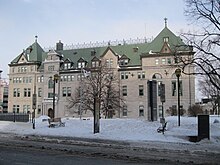
The municipal charter (Charte de la ville de Québec) regulates the responsibilities of the various authorities at the municipal level. The city council (conseil municipal) , elected every four years by majority vote , is the legislature . It has 21 councilors and the mayor. It determines the budget, approves the loans necessary for the administration of the city and the city districts, and issues regulations. In Canada, parties at the federal and provincial levels are typically separate from each other (members of one party need not necessarily belong to the other). In Québec this system also continues at the local level. The last city council elections took place on November 5, 2017. Currently represented on the council are the center-right Équipe Labeaume (15 seats), the left-wing groups Québec 21 (3 seats) and Démocratie Québec (1 seat) and two independents.
The ten-person executive committee (comité exécutif) is appointed from among the ranks of the city council, which exercises executive power and whose members are responsible for individual departments of the city administration. The chairman of the city council and the executive committee is the mayor (maire) , who is considered first among equals ; he is also chairman of the CMQ and the agglomeration council. Régis Labeaume has held this office since December 8, 2007 .
Québec is divided into six arrondissements . The boroughs are responsible for certain assigned tasks at the local level. Each arrondissement has its own district mayor (who is also a member of the city council) and a district council (conseil d'arrondissement) with three to five elected members. The district councils can submit proposals to the city council, which then require its approval.
City structure
After the parish mergers of 2002, Québec was divided into eight arrondissements . In 2009 their number was reduced to six. The arrondissements are further divided into 35 quarters for administrative purposes.
| Arrondissement | surface | Population (2011) |
|---|---|---|
| La Cité-Limoilou | 22.18 km² | 106.905 |
| Les Rivières | 48.61 km² | 69,070 |
| Sainte-Foy-Sillery-Cap-Rouge | 95.01 km² | 104.035 |
| Charlesbourg | 65.75 km² | 78,755 |
| Beauport | 74.34 km² | 77.905 |
| La Haute-Saint-Charles | 148.40 km² | 79,950 |
badges and flags
The coat of arms has existed in its current form since 1988. The tapering escutcheon at the bottom shows two golden keys on a red background, overlaid by a green maple leaf, in the gold-rimmed shield head , and below a golden sailing ship with full sails over white and blue waves. There are also two decorations: The sign rests a silver mural crown with red fields, under the shield is a banner with the motto of the town: Don de Dieu feray valoir ( "I will use God's gift good"), with Don de Dieu on refers to the name of Champlain's ship. The flag, introduced in 1987, shows the sailing ship in yellow on a blue background with a white battlement. The city uses a logo for day-to-day traffic with the authorities, which consists of the sailing ship in blue or white and the lettering Ville de Québec in reverse color.
Town twinning
The city has officially partnered with other cities since 1956 . The aim of these collaborations is to enable the exchange of information and expertise in areas of common interest. Particularly close cooperations exist with:
-
 Bordeaux (France) since 1962
Bordeaux (France) since 1962 -
 Calgary (Canada) since 1956
Calgary (Canada) since 1956 -
 Namur (Belgium) since 1999
Namur (Belgium) since 1999 -
 Paris (France) since 2003
Paris (France) since 2003 -
 Xi'an (China) since 2001
Xi'an (China) since 2001
In addition, there are collaborations in certain areas with:
Cityscape and architecture
Development of the architecture
In terms of architecture, Québec is considered the most European city in North America, which is mainly due to the well-preserved old town with its numerous buildings from the early modern era . The buildings of that era are strongly influenced by the architecture of French cities, but have a more robust construction method that is adapted to the harsh climate. Typical features are thick, often unplastered quarry stone walls made of dark limestone as well as framing of window and door openings made of lighter, often brightly painted stone . After a major fire destroyed many of the early wooden structures in 1682, binding building regulations came into force: All buildings had to be constructed as stone two-story semi-detached houses, and wood paneling was prohibited. The roofs, covered with copper or stone shingles, had to have an incline of at least 52 degrees in order to facilitate snow removal. Representative buildings from the French colonial era are built in the classicist baroque style.
The British conquest in 1759 had no immediate impact on the cityscape. Local builders and craftsmen carried out the reconstruction of destroyed buildings so that the French character was preserved. It was not until the early 19th century that typical British architectural styles such as Palladianism and neo-Gothic found their way. From the 1830s, when the city began to expand, classicism was added, used by both British and French-Canadian architects. Popular styles around the turn of the 20th century were Second Empire and Châteauesque (a North American variant of the Neo-Renaissance ). The architecture of the interwar period was shaped by Art Deco and European functionalism . The international style has prevailed in representative buildings since the middle of the 20th century . Due to the rapid suburbanization, the outer districts hardly differ from North American suburbs, apart from a few historic village centers. There are 37 National Historic Sites in Québec .
Old Town (Vieux-Québec)
In 1963, a law passed by the provincial parliament declared the old town a historic district (arrondissement historique) , and a year later its periphery as well. Since then, strict regulations have been in place to preserve the historical building fabric. Due to its great historical and architectural importance as the only walled settlement north of Mexico, UNESCO declared the old town of Québec a World Heritage Site on December 3, 1985 . Geographically, the old town can be divided into two parts. On the headland of Cap Diamant (the eastern end of the Colline de Québec plateau ) is the Upper Town (Haute-Ville), traditionally the administrative and institutional center of the city and residential area of the bourgeoisie and the nobility. On the narrow strip of land east and north of Cap Diamant, separated from the upper town by a difference in altitude of up to 90 meters, the lower town (Basse-Ville) stretches along the banks of the St. Lawrence River and Rivière Saint-Charles; this was once the traditional business, port and working-class district. In total, the old town covers an area of 135 hectares and comprises around 1400 buildings.
Upper town (Haute-Ville)
The Upper City is surrounded by the 4.6 km long city walls of Québec . In their current form, they were mostly built between 1745 and 1759. On their western side facing the plateau, they are supplemented by bastions and recessed flanks . Since the steep slopes of Cap Diamant offered natural protection, the walls on the north and east sides of the upper town are less complex. The Dufferin Terrace , a 430 meter long viewing terrace , completed in 1879, extends along the eastern flank . The original city gates were demolished in the 1860s and 1870s, the four today's are historicizing replicas. The Citadel of Québec , a star-shaped fortress, stands on the southern edge of the upper town . It was built between 1820 and 1832, the architect being inspired by Vauban's buildings . There are 24 buildings on the 15 hectare site; the former officers' barracks serves as the second residence of the Governor General of Canada .
Notre-Dame de Québec Cathedral was built in 1647 as the first Roman Catholic parish church north of Mexico. It was destroyed during the British siege in 1759 and then rebuilt. In 1843/44 it was given a classical facade, and in 1874 Pope Pius IX raised it . to the rank of minor basilica . The striking building with two towers burned down completely in 1922 and had to be restored as a result. It has had a Holy Door since 2013 (the first outside Europe). The extensive Séminaire de Québec building complex is attached to the cathedral . The Bishop's Palace in the immediate vicinity burned down in 1854; today the Parc Montmorency is located there . The Anglican Cathedral of Holy Trinity faces the former parade ground, Place d'Armes . The Palladian-style structure was completed in 1804 and is modeled on the London church of St Martin-in-the-Fields . Other buildings with a religious reference are the Hôtel-Dieu de Québec (hospital with attached Augustinian convent) and the Ursuline convent, which is mainly used as a school .
The Morrin Center , completed in 1814 , originally served as a prison; it was the first in Canada to mirror the ideas of British prison reformer John Howard . The building, built in the Palladian style, was later used as a school; today it serves as a cultural center. Opposite the Notre-Dame Cathedral is the Hôtel de Ville , the city hall. The building in the Second Empire style, completed in 1896, is one of the most stately administrative buildings in Canada with its opulent facade and richly decorated interior. It is a symbol of the eclecticism of the late Victorian era, much like the monumental Château Frontenac between Place d'Armes and Dufferin-Terrasse. This luxury hotel, modeled on the Loire castles , opened in 1893 and expanded several times until 1924. It dominates the Upper City skyline and is Québec's most famous landmark. Almost exactly in the middle of the upper town is the Édifice Price , an 18-story high-rise in Art Deco style. It was built in 1931 as the headquarters of Price Brothers and was met with heavy criticism at the time. Despite its height of 82 meters, the skyscraper is now considered to be well embedded in its surroundings because it looks relatively slim.
Lower town (Basse-Ville)
The oldest part of the city is the Place Royale . In 1608 it was the location of the first building built by Samuel de Champlain and for this reason is considered the "cradle of French civilization in America". There is the Notre-Dame-des-Victoires church, built in 1688 , the first all-stone church in North America. After being destroyed during the British siege, it was rebuilt between 1763 and 1766. In the 1970s, extensive restoration, dismantling and reconstruction work took place on the buildings around Place Royale in order to restore them to their late 18th century state. The project was controversial because it only took into account the French cultural heritage and later building developments from the British and Canadian times were reversed.
The Petit Champlain district to the south of Place Royale has been able to retain its original character without extensive reconstruction. On the narrow Rue du Petit-Champlain, a pedestrian zone following the foot of the steep cliff, there are several residential and commercial buildings from the late 17th and early 18th centuries. This includes the house of French explorer Louis Joliet , built in 1683 . The facade of another house is decorated with a 420 m² trompe l'œil fresco depicting various scenes from the city's history. North of the Place Royale, at the mouth of the Rivière Saint-Charles , is the old port (Vieux-Port) , which is now used as a marina . Several dozen open staircases lead from the lower to the upper town and from there to other parts of the city close to the center, most of which have wooden steps. Stairs have played an important role in the life of the city since the 17th century, as they allow significant shortcuts in steep terrain. The oldest and best known is the Escalier Casse-cou ("neckbreaker staircase") from the Quartier du Petit Champlain up to the Parc Montmorency , built around 1660 .
government District
Opposite the Porte Saint-Louis, the main gate of the city walls, is the Colline parlementaire ("Parliament Hill"), the government district of the province of Québec. The reference point of the district is the Hôtel du Parlement , built between 1877 and 1886 in the Second Empire style , in which the National Assembly of Québec meets (until 1968 also the Legislative Council , the dissolved upper house). The monumental building consists of four wings that are arranged around an inner courtyard; the architect was inspired by the extension of the Louvre in Paris . An eight-story tower dominates the front facade. In the roundabout in front of the parliament building is the Fontaine de Tourny , a fountain built in 1855 in the twin city of Bordeaux , which was brought to Québec in 2007 as a gift for the upcoming 400th anniversary celebration.
The parliament building is surrounded on three sides by office and hotel high-rise buildings from the 1970s. The tallest building in the city has been the 132 m high Édifice Marie-Guyart since 1972 . On the top of the 31 floors is the Observatoire de la Capitale , a publicly accessible viewing platform. Due to its height of 221 m above sea level, it offers an almost unrestricted panorama of the entire city and the surrounding region. A little south of the parliament building is the Manège militaire , a riding and parade hall. The headquarters of the Voltigeurs de Québec , the oldest French-Canadian regiment, was built in 1887 in neo-Renaissance style. It is the only institution of its kind in Canada that has a clear architectural reference to France. After a devastating fire in April 2008, only the facades remained, and by 2017 the building is to be reconstructed at a cost of over 100 million Canadian dollars.
Remaining city area
The Saint-Roch district to the west of the upper town was the dominant business and industrial district until the 1960s, as can be seen in well-preserved examples of industrial architecture . Particularly noteworthy is the La Fabrique building, which dates back to 1871 , the former underwear factory of Dominion Corset , which has been used by a university faculty since 1994. On the western edge of the quarter, right on the border of the Notre-Dame-des-Anges enclave , the windmill of the Hôpital général de Québec has stood since 1730 , one of only 18 preserved historical windmills in the province. The French General Louis-Joseph de Montcalm is buried in the enclave's cemetery.
Sillery, located in the central part of the Colline de Québec, was the traditional posh suburb of Québec until it was incorporated in 2002. The historic district includes 350 19th-century houses, including Domaine Cataraqui (provincial government guest house) and Villa Bagatelle . The Jesuit house dates from the early 18th century . The historic district of Beauport extends over a length of 6 km on a terrace parallel to the Saint Lawrence River and includes 650 buildings from the 18th to early 20th centuries. Another historic district is Trait-Carré, the center of the Charlesbourg arrondissement, with several agricultural buildings from the late 17th and 18th centuries. This includes the Jesuit mill from 1740. A special tourist attraction in Charlesbourg is an ice hotel , which is open from January to March.
Green spaces

On the Colline de Québec, to the southwest of the old town, facing the steep slope facing the St. Lawrence River, there are several parks that form an elongated "green lung". The leveled glacis of the city fortifications is located between the parliament building and the citadel . To the southwest of it lies the 98 hectare Abraham Plain . The extensive scene of the decisive battle of 1759 is structured by valleys and small forests; there are also two of the three Martello towers that have survived . Delimited by another piece of forest, the Parc du Bois-de-Coulonge and two cemeteries follow to the southwest .
The Parc des Braves in the Montcalm district was the site of the Battle of Sainte-Foy in 1760 . Together with the Abraham level, it is administered by a commission of the Canadian federal government under the collective name Parc des Champs-de-Bataille ("Battlefield Park "); both are therefore considered to be urban national parks. Below the steep southern slope of the Colline de Québec, the Champlain Promenade stretches along the banks of the Saint Lawrence River. A 2.6 km long section of the local shore zone is a public accessible beach (Parc de la Plage-Jacques-Cartier).
The Cartier-Brébeuf National Historic Site is a park on the lower reaches of the Rivière Saint-Charles. It is also the location of the former Iroquois village of Stadacona , Jacques Cartier's first fort and Jean de Brébeuf's first mission station. The entire length of the course of the Rivière Saint-Charles, from its mouth to Lac Saint-Charles , is followed by the Parc linéaire des rivières Saint-Charles et du Berger . This linear park crosses on the one hand Parc Chauveau (with 120 hectares the largest park in the city) and on the other hand, near Wendake, the Parc de la Falaise with the Kabir Kouba waterfall .
The Domaine de Maizerets is an extensive landscaped garden two and a half kilometers north of the city center, which was laid out around a manor house built in 1705. It includes u. a. an arboretum, a maze, a rose garden and an elm grove. The Jardin botanique Roger-Van den Hende , a botanical garden with over 4,000 species of plants, is located on the campus of the Université Laval in the Sainte-Foy district . On the eastern outskirts, around the Montmorency Falls, is the Parc de la Chute-Montmorency ; the difference in altitude of 83 meters can be overcome with a cable car.
Economy and Infrastructure
The administrative region Capitale-Nationale , three-quarters of the population of which lives in the city of Québec, generated a gross domestic product (GDP) of CAD 32.543 billion in 2012 . This corresponds to a share of 9.8% in the economic output of the province of Québec. With a per capita GDP of 43,862 dollars (2011), Capitale-Nationale took fourth place among the 17 administrative regions. The most important economic sector in the city is by far the service sector with a share of 86% of the workforce, industry and construction together make up 13%, the rest is made up of the primary sector with forestry and agriculture . From 2010 to 2013, the unemployment rate in the metropolitan area of Québec averaged 5.0%, which is around 2.8 percentage points below the average for the entire province.
Primary sector
Since the early 20th century, forestry has shifted its focus from purely wood extraction to maintaining the stock and applied research in the field of materials science. Various mining companies are based in Québec, but there are no mines. The agriculturally usable area is about a fifth of the urban area. In 2002 there were 121 farms. These are mainly located in the fertile St. Lawrence Lowlands in the west of the city. The most important sectors are dairy farming , pig breeding , potato and vegetable cultivation and poultry production .
Industry
There are 26 industrial zones within the urban area. Most of them extend along the main traffic axes, with a concentration on Autoroute 40 in the southern part of the Saint-Charles Valley. In the last few decades there has been a shift from the domestic market -oriented consumer goods industry to export-oriented cutting - edge technology , in cooperation with the local research institutions. In 2003, the Québec International Organization was founded with the aim of promoting foreign investment in the “knowledge-based” economy. A particularly large number of companies are active in the areas of life sciences , information and communication technology , the electrical industry , materials development , environmental technology , energy technology and the food industry.
Various international companies are represented in the city with branches and operating facilities. These include AkzoNobel , Asea Brown Boveri , CGI , Fujitsu , General Electric , GlaxoSmithKline , STERIS , Thales Group and Veolia Environnement . The once flourishing wood processing industry , which shaped the economic development to a large extent for three centuries, is of secondary importance today. After a concentration process, only one paper mill is still in operation: the Stadacona mill, founded in 1928 by the Anglo-Canadian Pulp & Paper Mills and part of the US White Birch Paper group since 2004 , is North America's third largest producer of newsprint.
Services
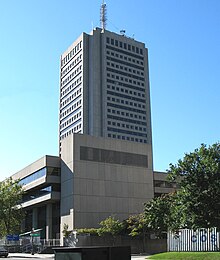
Public administration has a high share in the service sector with 15% of all employees (almost three times higher than the provincial average). In addition to the ministries of the provincial government and the departments of the city administration, various state or state-affiliated companies also belong to this category. Québec is u. a. Headquarters of the Caisse de dépôt et placement du Québec (pension fund), the Institut national d'optique (research institute), the Société des établissements de plein air du Québec (national park administration), the Société de l'assurance automobile du Québec (vehicle insurance), the Autorité des marchés financiers (financial supervision) and the Société des alcools du Québec (alcohol management).
Québec is also the location of several international organizations . These include the Organization of World Heritage Cities , an association of 250 cities with world heritage sites, and the Inter-American organization for higher education , which promotes exchange between universities in North and South America. There are also two sub-organizations of the International Organization of Francophonie : the Institut de l'énergie et de l'environnement de la francophonie coordinates the environmental and energy policies of the member states, while the Center international de documentation et d'échange de la francophonie promotes cultural exchange .
Another important mainstay are insurance and financial services . Ten insurance companies are headquartered in the metropolitan area of Québec, making it the second most important location for this industry in Canada. The most important representatives are the Industrial Alliance and Promutuel . A cluster in the field of computer game programming has developed in Québec . The best known of these game developers are Frima Studio and Ubisoft Québec . Various service companies are also based in the city, including Chez Ashton (fast food chain), Familiprix (drug stores), Groupe F. Dufresne (fuel trade) and La Maison Simons (fashion stores).
Due to the numerous sights and cultural offerings, tourism is an important economic factor. In 2010, the Québec tourist region, which in addition to the city also includes the surrounding regions of L'Île-d'Orléans , La Côte-de-Beaupré , La Jacques-Cartier and Portneuf , counted 4.5 million tourists (including 1 million from the Foreign countries). This makes Québec the fourth most visited destination in Canada after Montreal , Toronto and Vancouver . In 2010 tourism generated sales of $ 1.34 billion and created 23,600 full-time positions.
media
As in the rest of the province, four television channels share most of the French-speaking market; they are each represented in the city of Quebec with regional branches and broadcasting studios. In the public institution CBC / Radio-Canada is the transmitter CBVT , on private networks TVA , Télé-Québec and V there are the stations CFCM , CIVQ and CFAP . In English it is the broadcaster CKMI of the private Global Television Network . There are also several radio stations .
In Québec, the daily newspapers Le Soleil and Le Journal de Québec , several weekly newspapers with local distribution and various magazines appear in French . The English-language weekly Quebec Chronicle-Telegraph has existed since 1764 and claims to be the oldest newspaper in North America.
Utilities and public institutions
The water supply is ensured by the Service de l'environnement , a joint operation of the agglomeration communities. Slightly more than half of the drinking water comes from the Rivière Saint-Charles or Lac Saint-Charles , one fifth from the Saint Lawrence River , one sixth from the Rivière Montmorency , the rest from spring taps. All of the wastewater is treated in two sewage treatment plants , and a dozen underground retention basins are available in the event of large amounts of rain . The electricity is supplied by Hydro-Québec , the gas supply by Gaz Métro .
All of the city's public hospitals have been part of the Center hospitalier universitaire de Québec network , which is linked to the Université Laval , since 2012 . This includes the Hôtel-Dieu de Québec , founded in 1639 , the oldest hospital in North America. The city police department, the Service de police de la Ville de Québec , has existed since 1843 and has a little more than 700 employees. There has been a fire brigade in the city since 1765; Today's Service de protection contre les incendies de Québec was created in 2002 through the merger with the fire departments of various neighboring communities.
traffic
Roads and bridges
Québec is a major hub in the province's motorway network . The Autoroute 40 connects the city to Trois-Rivières , Montreal and the province of Ontario . Autoroute 20 runs south of the St. Lawrence River ; to the west it leads to Montreal and Toronto , and to the east to Rivière-du-Loup . Autoroute 73 serves as a crossbar between these highways : It begins near the northern outskirts, crosses the river and ends near Saint-Georges . The network is supplemented by four short city highways: the Autoroute 440 , the Autoroute 540 , the Autoroute 573 and the Autoroute 740 . The most important national main road is Route 138 ; it runs parallel to the north bank of the Saint Lawrence River, from the border with New York State to the Labrador Peninsula . Other national roads are route 136 and route 175 .
Three bridges cross the St. Lawrence River. The Pont Pierre-Laporte motorway bridge leads from the Sainte-Foy district to Lévis . It was opened in 1970 and, with a total length of 1,041 meters, is the longest suspension bridge in Canada. 200 meters west of it is the Québec Bridge , opened in 1919 , a 987-meter-long cantilever truss bridge for rail and road traffic. The 4.4 km long Pont de l'île d'Orléans , opened in 1938, leads from the Beauport district to the Île d'Orléans , an island in the Saint Lawrence estuary.
The cycle path network in Québec extends over a length of more than 400 km. In addition to the usual cycle lanes, there are four separate, continuous cycle corridors. The longest continuous cycle path is the Corridor du Littoral (48 km), which runs along the banks of the Saint Lawrence River between Cap-Rouge and the Montmorency Falls. The Corridor des Cheminots (22 km) follows the route of a disused railway line between the city center and Val-Bélair. The Corridor de la Rivière Saint-Charles (9 km) circles the lower reaches of the Rivière Saint-Charles and the Corridor des Beauportois (5.7 km) crosses the Beauport district. The first two corridors mentioned are part of the Route Verte and the Sentier transcanadien .
Aviation and shipping
Québec International Airport (Aéroport international Jean-Lesage de Québec) is twelve kilometers west of the city center. It was opened in 1939 and has around 1.75 million passengers annually, making it the second largest airport in the province in terms of passenger volume. The port of Québec on the Saint Lawrence River is the oldest in Canada; today it is particularly important as a starting point for cruise ships . The Société des traversiers du Québec operates a ferry service between the lower city of Québec and Lévis.
Rail and local transport
From Québec's main train station, the Gare du Palais , several VIA Rail express trains run to Montreal every day . The Gare du Palais also serves as a terminal for numerous long-distance bus routes . Another train station is located in the Sainte-Foy district. Trains from Montreal to Halifax and Gaspé do not run via Québec, but stop at Charny Station on the opposite bank. The railroad lines that start from Québec and are located north of the Saint Lawrence River are now used almost exclusively for freight traffic. An exception is a completely tourist-oriented offer to La Malbaie on the Quebec – Clermont railway line .
The transport company Réseau de transport de la Capitale (RTC) operates a dense bus network with several dozen lines in Québec and several neighboring communities . The backbone is formed by four Métrobus lines, which have separate bus lanes in a particularly dense cycle and over almost their entire length . There is a uniform tariff structure using the contactless OPUS chip card . The Société de transport de Lévis is responsible for connections across the Québec Bridge to the neighboring city of Lévis . A funicular , the Funiculaire du Vieux-Québec, opened in 1879, runs between the Rue du Petit-Champlain in the lower town and the Dufferin Terrace above .
The history of local public transport began in 1845 with the introduction of a horse-drawn bus route between Québec and Cap-Rouge. Twenty years later the first horse tram followed in the lower town . Electric trams ran from 1897 until the changeover to bus operation in 1948, and there was also an Interurban to the pilgrimage site of Sainte-Anne-de-Beaupré between 1899 and 1957 . In 2003 RTC published a feasibility study on the reintroduction of the tram, but the project is politically blocked.
education
The Université Laval is the oldest continuously existing Francophone educational institution on the American continent. It was founded in 1663 as a seminary of the Jesuits ( Séminaire de Québec ) and converted into a full university in 1852. It has around 48,000 students, making it one of the largest universities in Canada. Almost all university facilities are concentrated on the 1.9 km² campus in the Sainte-Foy district; individual faculties use the seminar buildings in the old town. The TÉLUQ (Télé-Université) long-distance university, founded in 1972, is a member of the Université du Québec . In addition to the two universities, there are two other universities, the École nationale d'administration publique and the research institute Institut national de la recherche scientifique .
At the middle school level there are four state Cégeps ( Collège d'enseignement général et professionnel ) in Québec , which combine preparation for university education and technical vocational school. Of these, three are in French and one in English. There are also nine private secondary schools. Four school authorities operate in the Québec agglomeration and are responsible for kindergartens, elementary and secondary schools, adult education and vocational training. French-speaking school authorities are the Commission scolaire des Premières-Seigneuries in the east, the Commission scolaire de la Capitale in the center and the Commission scolaire des Découvreurs in the west. The Central Quebec School Board oversees the English-language classes . The supervision is carried out by school councils who are elected by the residents of the supervised areas.
Culture
Cultural policy under the sign of Francophonie
From the late 19th century onwards, Québec increasingly identified itself in the cultural sense as the “national capital” of the Francophones, which was intended to compensate for the loss of political importance compared to the federal capital Ottawa . The French, Catholic and traditional character should be preserved with commemorations and gatherings. This sense of mission was not limited to the province of Québec, but included all francophone areas of North America. Large celebrations and military parades were planned for 1909 to mark the 150th anniversary of the Battle of the Plains of Abraham , which caused unease among French Canadians. Political pressure from Québec meant that the celebrations were postponed by a year and instead dedicated to the 300th anniversary of the founding of the city by Samuel de Champlain . In 1912, 1937, 1952 and 1957 "Congresses of the French Language in Canada" were held in Québec with the aim of ensuring the survival of the French language in North America.
With the silent revolution of the 1960s, cultural policy took on emphatically secular and internationalist features (sometimes also separatist ). The Superfrancofête in August 1974, a twelve-day cultural festival with actors from 25 francophone countries and with a special focus on youth culture, attracted 1.25 million visitors and served as a model for similar events in the following decades. In 1979, the International Association of Francophone Mayors was founded in Québec, and in 1987 and 2008 the city hosted the Francophone Summit. The city's 400th anniversary was celebrated in 2008 with dozens of international events.
Regular major events
The Québec Carnival (Carnaval de Québec) takes place from late January to mid-February . It offers a wide range of carnival, cultural and sporting activities, in which around one million visitors take part. These include a. Masked balls, parades, an ice sculpture competition and ice canoe races on the partially frozen St. Lawrence River. The first carnival took place in 1894, the official ambassador is a snowman named Bonhomme carnaval ("Carnival man").
The Défilé de la Saint-Patrick de Québec is a March 17th parade. Due to the large number of Irish immigrants in the 19th century, St. Patrick's Day has a long tradition in Québec. After the move was first carried out in 1837, the custom was gradually forgotten in the 1920s, until it was revived in 2010.
The Fête nationale du Québec has been the official national holiday of the province of Québec since 1977. It falls on June 24th ( St. John's Day), the commemoration of Quebec's national saint, John the Baptist . With around 200,000 visitors, the Abraham level event is the largest in the entire province. The actual Canadian national holiday, Canada Day on July 1st, is attracting less interest.
With 1.5 million visitors, the Québec Summer Festival (Festival d'été de Québec), first held in 1968, is the largest event of the year. This music and culture festival begins on the first Thursday in July and lasts eleven days each. Around 1000 artists appear on ten stages in 300 events. The spectrum ranges from pop and rock to world music and classical music. The highlight are open-air concerts on the Abraham level in front of around 100,000 spectators. The Expo Québec , which takes place at the end of August, is a major goods and agricultural fair that has existed since 1894 on the ExpoCité exhibition grounds .
Museums

The Musée national des beaux-arts du Québec is the largest museum in the city and the National Museum of the Province of Québec. This art museum specializes in works related to Québec or created by Quebec artists. In the three exhibition buildings on the Abraham level, over 37,000 works of all art styles since the 17th century are presented. The opening of a fourth building is planned for 2016.
The museum association Les Musées de la civilization deals with various historical aspects. One of the most visited museums in Canada is the Musée de la civilization , which is housed in a building designed by Mosche Safdie . This "Museum of Civilization" offers permanent exhibitions on the cultural history of Québec and the indigenous people, as well as changing exhibitions on various contemporary and historical topics. The Musée de l'Amérique francophone presents the French culture of North America, while the Maison historique Chevalier presents the living culture of the 18th and 19th centuries. Finally, the Musée de la place Royale explains the history of the Place Royale .
In the Musée naval de Québec at the old port, the history of shipping on the Saint Lawrence River and the Canadian Navy is presented. The Musée de géologie René-Bureau is an exhibition hosted by the geological faculty of the Université Laval with thousands of rock samples, minerals and fossils. The Ursuline Convention runs the Musée des Ursulines de Québec on the history and cultural significance of this religious community. A museum in the citadel tells the history of the 22nd regiment of the Canadian Army stationed there. In addition, there are numerous smaller exhibition centers and interpretive centers that impart knowledge and skills about specific sections of the natural and cultural sciences with a regional reference.
The Aquarium du Québec is located in Sainte-Foy . In this large aquarium with separate saltwater and freshwater areas, more than 10,000 animals can be viewed, belonging to around 300 different species that predominantly occur in Canada. In 2006, the aquarium took over part of the holdings of the Jardin zoologique du Québec , which had to be closed in 2006 for financial reasons.
Theater, music, literature
Québec is a stronghold of theater , with improvisational theater and the form of theater sport derived from it enjoying great popularity. There are several important theater and event buildings in the city. The largest is the Grand Théâtre de Québec with 2,600 seats. It is also the seat of the theater company Théâtre du Trident and the Conservatoire de musique de Québec . In the Capitole de Québec and in the Palais Montcalm there is space for 1,100 spectators each, in the Impérial de Québec 1,300 and in the Salle Albert-Rousseau 1350. There are also several small theaters.
The halls mentioned are also used for musical performances. For example, the Orchester Symphonique de Québec symphony orchestra and the Opéra de Québec opera company regularly perform at the Grand Théâtre de Québec. The Agora du Vieux-Port is also used for concerts , an open-air stage at the old port for over 4,000 spectators. Several cultural festivals are held in Québec every year. The Festival de la bande dessinée francophone de Québec is the oldest and largest comic festival in North America for French-language publications. It has been part of the Salon international du livre de Québec book fair since 2005 .
Sports
Ice hockey is the most popular sport in Québec in terms of audience interest. The Remparts de Québec play in the Ligue de hockey junior majeur du Québec , one of three professional junior leagues in Canada. They play their home games at the Center Vidéotron , which has a capacity of 18,500 and was opened in September 2015. The intention behind the construction of the new stadium is to bring another team from the National Hockey League (NHL), the highest professional ice hockey league in North America, to Québec. The Nordiques de Québec had played in the World Hockey Association from 1972 to 1979 , then in the NHL, until the team moved to Denver in 1995 (where it appears as the Colorado Avalanche ). The Nordiques played their home games in the 15,400-seat Colisée Pepsi . Another ice hockey stadium is the Pavillon de la Jeunesse with 5000 seats.
The Capitales de Québec play baseball in the Can-Am League; They play their home games in the Stade Municipal , which has a capacity of 5,100 spectators. The women's football club Amiral SC de Québec is represented in the USL W-League . Under the name Rouge et Or ("Red and Gold"), Université Laval provides teams in over a dozen sports.
Several major sporting events take place in Quebec. Since 1984, the renowned Transat Québec Saint-Malo offshore regatta has been attracting world-class international sailors and amateurs every four years. The sailing regatta leads across the North Atlantic to Saint-Malo , the hometown of Jacques Cartier , without stopping . It is the only transatlantic regatta for teams in a west-east direction. The Challenge Bell has been held annually since 1993 , an important women's tennis tournament on the WTA Tour . The 2010 inaugural Grand Prix Cycliste de Québec is a one-day - cycling race during the UCI World Tour . The extreme sports event Red Bull Crashed Ice , which contains elements of ice hockey and snowboard cross , also attracts large numbers of spectators ; the race in Québec is part of the unofficial world championship organized by Red Bull .
Québec applied to host the 2002 Winter Olympics , but the candidacy had no chance at the 1995 IOC session in Budapest . Another application with a view to the 2010 Winter Olympics failed in the internal Canadian selection at the eventual venue Vancouver . Québec may apply to host the 2026 Winter Games. In 1967 the city hosted the first edition of the Canada Games , and in 2005 the World Police and Fire Games . The ice hockey world championship took place here in 2008 (together with Halifax ), and in 2011 the figure skater's Grand Prix final .
There are 21 indoor swimming pools available in Québec and an additional 42 outdoor pools in summer . A popular pastime in winter is ice skating . Québec has 12 urban indoor artificial ice rinks (which are also used for ice hockey) and several dozen outdoor ice rinks. Cross-country skiing can be practiced on trails with a length of around 125 km . In the immediate vicinity, just outside the city limits, there are three winter sports areas in the Laurentine Mountains , which are also the venue for professional winter sports competitions: Mont Sainte-Anne , Le Relais and Stoneham .
Personalities
Québec is the birthplace and place of work of numerous prominent personalities, for example Guy Laliberté (founder of the Cirque du Soleil ). Due to the close ties that have arisen in the city of Québec between federal, provincial and local politics over the decades, numerous well-known politicians come from here. Both mayor of the city and prime minister of the province of Québec were Narcisse-Fortunat Belleau and Simon-Napoléon Parent . The office of Quebec Prime Minister was Pierre-Joseph-Olivier Chauveau , Jean Lesage , Pauline Marois and John Jones Ross . One of the founding fathers of the Canadian state is Hector-Louis Langevin , and Robert Taschereau was Chairman of the Supreme Court of Canada. Pierre de Rigaud was the only governor of New France who was not born in Europe. The most famous athletes are mainly ice hockey players who have won the Stanley Cup several times . These include Patrice Bergeron , Simon Gagné , Marcel Pronovost and Patrick Roy . In addition, Myriam Bédard was one of the most successful biathletes of the 1990s.
literature
- Serge Courville, Robert Garon: Québec, ville et capitale . Les Presses de l'Université Laval, Québec 2001, ISBN 2-7637-7674-4 ( online ).
- Jean-Marie Lebel, Alain Roy: Québec 1900–2000, le siècle d'une capitale . Éditions Multimondes, Québec 2000, ISBN 2-89544-008-5 ( online ).
- Div. Authors: Quebec City . Ulysses Travel Guides, Montreal 2005, ISBN 2-89464-729-8 ( online ).
- Guy Lessard, Emmanuelle Boulfroy, Patrick Blanchet, David Poulin: Québec, ville de bois. (PDF; 6.3 MB) Center de renseignement et de recherche en foresterie de Sainte-Foy, 2008, accessed on September 1, 2014 (French).
- Pierre Anctil, Simon Jacobs Eds .: Les Juifs de Québec. Quatre cents ans d'histoire. Presses de l ' Université du Québec PUQ, Québec 2015
Web links
- Official website of the City of Québec (French, English, Spanish)
- Tourism in Québec (French, English)
- Quebec City - Ville de Québec ( English, French ) In: The Canadian Encyclopedia . Retrieved July 30, 2019.
Individual evidence
- ↑ Québec (Canada): Province, Cities & Towns - Population Statistics, Maps, Charts, Weather and Web Information. Retrieved September 1, 2018 .
- ↑ Distance from Québec to… timeanddate.com, accessed on September 1, 2014 (English).
- ↑ Les plus grands cours d'eau du monde. Environment and Climate Change Canada , July 22, 2013, accessed September 1, 2014 (French).
- ^ Courville, Garon: Québec, ville et capitale. P. 10.
- ^ Courville, Garon: Québec, ville et capitale. Pp. 23-24.
- ↑ a b Plan directeur des milieux naturels et de la forêt naturel. (PDF, 19.6 MB) City of Québec, 2006, p. 3 , archived from the original on September 22, 2015 ; Retrieved September 1, 2014 (French).
- ^ Courville, Garon: Québec, ville et capitale. Pp. 22-23.
- ^ Courville, Garon: Québec, ville et capitale. Pp. 26-27.
- ^ Ligne de temps. In: L'archéologie à Québec. City of Québec, accessed September 1, 2014 (French).
- ^ Courville, Garon: Québec, ville et capitale. P. 11.
- ↑ 2.3 Géologie et pédologie. Organisms des basssins versants de la Capitale, January 14, 2014, accessed on September 1, 2014 (French).
- ^ Repertoire des municipalités. Province of Québec, Department of Communities and Housing, 2020, accessed April 18, 2020 (French).
- ↑ Canadian Climate Normals 1981-2010, Aéroport international Jean-Lesage de Québec. Environment and Climate Change Canada, February 13, 2014, accessed September 1, 2014 .
- ^ Courville, Garon: Québec, ville et capitale. P. 16.
- ↑ Lessard et al .: Québec, ville de bois. P. 5.
- ↑ À la découverte des parcs naturels de Québec. (No longer available online.) Association forestière des deux rives, archived from the original on November 3, 2014 ; Retrieved September 1, 2014 (French).
- ↑ a b Mammifères. Organisms des basssins versants de la Capitale, January 14, 2014, accessed on September 1, 2014 (French).
- ^ Répartition geographique du loup et du coyote au sud du 52 e parallèle et estimation de la population de loups au Québec. Retrieved March 23, 2019 .
- ↑ Herpétofaune. Organisms des basssins versants de la Capitale, January 14, 2014, accessed on September 1, 2014 (French).
- ↑ Avifaune et oiseaux nicheurs. Organisms des basssins versants de la Capitale, January 14, 2014, accessed on September 1, 2014 (French).
- ↑ Ichtyofaune. Organisms des basssins versants de la Capitale, January 14, 2014, accessed on September 1, 2014 (French).
- ↑ a b c Québec. Commission de toponymie du Québec, accessed September 5, 2014 (French).
- ↑ Gentile: nom des habitants d'un lieu. Commission de toponymie du Québec, accessed September 5, 2014 (French).
- ^ Lac Saint-Charles. In: L'archéologie à Québec. City of Québec, accessed September 5, 2014 (French).
- ^ Place Royale. In: L'archéologie à Québec. City of Québec, accessed September 5, 2014 (French).
- ^ Séminaire de Québec. In: L'archéologie à Québec. City of Québec, accessed September 5, 2014 (French).
- ↑ Marcel Trudel: Jacques Cartier . In: Dictionary of Canadian Biography . 24 volumes, 1966–2018. University of Toronto Press, Toronto ( English , French ).
- ↑ Québec ... (avant 1608). In: City of Quebec. City of Québec, accessed April 18, 2020 (French).
- ↑ Bruce Trigger : The Disappearance of the St. Lawrence Iroquoians . In: The Children of Aataentsic: A History of the Huron People to 1660 . McGill-Queen's University Press, Montreal 1976, ISBN 0-7735-0627-6 , pp. 214-228 .
- ↑ Claude Chapdelaine: Overview of the St. Lawrence Archaic Through Woodland , in: Timothy R. Pauketat: The Oxford Handbook of North American Archeology , Oxford University Press, 2012, pp. 249-261, here: pp. 258 f.
- ↑ Jacques Lacoursière: Le 3 juillet 1608 - La fondation de Québec: les Français s'installent en Amérique du Nord. Fondation Lionel-Groulx, October 13, 2011, accessed on September 8, 2014 (French).
- ^ Alan Taylor: American Colonies. The Settlement of North America to 1800. Viking / Penguin 2001 a. ö., p. 100
- ^ John S. Moir: David Kirke . In: Dictionary of Canadian Biography . 24 volumes, 1966–2018. University of Toronto Press, Toronto ( English , French ).
- ^ Courville, Garon: Québec, ville et capitale. P. 66.
- ^ Jacques Leclerc: L'implantation du français au Canada. Université Laval, 2014, accessed November 5, 2014 (French).
- ↑ James Powell: A history of the Canadian Dollar . Bank of Canada , Ottawa 2005, ISBN 0-660-19571-2 , pp. 4-10 ( PDF ).
- ^ Jacques Lacoursière: Histoire populaire du Québec: Des origines à 1791 . Septentrion, Sillery 1995, ISBN 2-89448-050-4 , pp. 196 .
- ↑ La metropole s'en mêle. In: Lieu historique national du Canada des Fortifications-de-Québec. Parks Canada , October 5, 2011, accessed September 8, 2014 (French).
- ^ Courville, Garon: Québec, ville et capitale. P. 106.
- ^ Courville, Garon: Québec, ville et capitale. P. 118.
- ↑ Au tour des conquérants. In: Lieu historique national du Canada des Fortifications-de-Québec. Parks Canada , October 5, 2011, accessed September 10, 2014 (French).
- ^ Courville, Garon: Québec, ville et capitale. Pp. 107-108.
- ^ Courville, Garon: Québec, ville et capitale. P. 146.
- ↑ Lessard et al .: Québec, ville de bois. Pp. 19, 22.
- ↑ Lessard et al .: Québec, ville de bois. P. 25.
- ↑ Une ville assiégée. In: Lieu historique national du Canada des Fortifications-de-Québec. Parks Canada , October 5, 2011, accessed September 10, 2014 (French).
- ^ Courville, Garon: Québec, ville et capitale. Pp. 154-157.
- ^ Charles Dickens : American Notes for General Circulation at Project Gutenberg .
- ^ Choléra à Québec. Grand Québec, accessed November 9, 2015 (French).
- ^ Courville, Garon: Québec, ville et capitale. P. 238.
- ↑ David-Thiery Ruddel, Marc Lafrance: Québec, 1785-1840 :problemèmes de croissance d'une ville coloniale . Ed .: Social history / Histoire sociale. Vol. 18, No. 36 , 1986, ISSN 1918-6576 , pp. 322-323 ( PDF ).
- ^ Courville, Garon: Québec, ville et capitale. Pp. 166-170.
- ↑ Faits interests. In: Lieu historique national des Fortifications-de-Québec. Parks Canada , January 18, 2012, accessed September 10, 2014 (French).
- ↑ SOS! Les catastrophes du Canada. Library and Archives Canada , February 14, 2006, accessed September 10, 2014 (French).
- ^ Paul-André Linteau, René Durocher, Jean-Claude Robert: Quebec: A History 1867-1929 . Lorimer Publishing, Toronto 1983, ISBN 0-88862-604-5 , pp. 134-136 .
- ^ Lebel, Roy: Québec 1900–2000, le siècle d'une capitale. Pp. 19-20.
- ↑ Une ère de transformation (1867–1945). City of Québec, 2014, accessed April 18, 2020 (French).
- ^ Lebel, Roy: Québec 1900–2000, le siècle d'une capitale. Pp. 17-18.
- ^ Courville, Garon: Québec, ville et capitale. Pp. 316-319.
- ^ Lebel, Roy: Québec 1900–2000, le siècle d'une capitale. Pp. 23-24, 27.
- ^ Lebel, Roy: Québec 1900–2000, le siècle d'une capitale. Pp. 41-42.
- ^ Courville, Garon: Québec, ville et capitale. Pp. 271-272.
- ^ Lebel, Roy: Québec 1900–2000, le siècle d'une capitale. Pp. 76-77.
- ↑ Baptiste Ricard-Châtelain: Une autoroute sous la ville: Québec métropole millionnaire de béton. Le Soleil , July 23, 2012, accessed September 12, 2014 (French).
- ^ Sous le signe de la modernité (1945–2008). City of Québec, 2014, accessed April 18, 2020 (French).
- ↑ Div. Authors: Quebec City. Pp. 22-24.
- ↑ RCMP uses 'excessive force' at Quebec summit: report. CBC News , November 13, 2003, accessed September 12, 2014 .
- ↑ Répères chronologiques. (PDF, 207 kB) City of Québec, archived from the original on October 6, 2014 ; Retrieved September 9, 2014 (French).
- ↑ Consultation sur la réorganisation territorial. Ministère des Affaires municipales, des Régions et de l'Occupation du territoire, February 13, 2014, accessed on September 9, 2014 (French).
- ↑ Référendums du 20 juin 2004. Directeur général des élections du Québec, accessed on September 9, 2014 (French).
- ↑ a b Population profile of the city of Québec. In: 2011 Census. Statistics Canada , 2011, accessed September 13, 2014 (French).
- ↑ Population profile of the Québec agglomeration. In: 2011 Census. Statistics Canada , 2011, accessed September 13, 2014 (French).
- ↑ Population profile of the metropolitan area of Québec. In: 2011 Census. Statistics Canada , 2011, accessed September 13, 2014 (French).
- ↑ Evolution historique de la population des municipalités au Québec. (PDF, 288 kB) In: Données sociodémographiques en bref. Institut de la statistique du Québec, February 2008, accessed September 13, 2014 .
- ^ Profile de la communauté anglophone de Québec. Commissariat aux langues officielles, January 15, 2013, accessed September 13, 2014 (French).
- ↑ Population profile of the city of Québec. In: 2001 Census. Statistics Canada , 2001, accessed September 13, 2014 (French).
- ↑ Konrad Yakabuski: Neither practicing nor believing, but even Catholic way. The Globe and Mail , August 14, 2009, accessed September 13, 2014 .
- ↑ Caractéristiques de la population des minorités visibles. In: Québec City Population Profile 2006. Statistics Canada , December 6, 2010, accessed September 13, 2014 (French).
- ↑ Profil de la population autochtone de 2006. In: Census 2006. Statistics Canada , December 6, 2010, accessed on September 13, 2014 (French).
- ↑ Marie-Eve Sylvestre, Céline Bellot: Challenging Discriminatory and Punitive Responses to Homelessness in Canada , in: Martha Jackman, Bruce Porter (ed.): Advancing Social Rights in Canada , Irwin Law, 2014, pp. 2–29, here: P. 16.
- ^ A comparative study was provided by I. Glasser, Louise Fournier, A. Costopoulos: Homelessness in Quebec City and Hartford, Connecticut , in: Urban Anthropology 28 (1999) 141-163.
- ↑ Eliseu Luiz Turchetto: Les hommes sans domicile fixe et leur rapport aux services de santé et services sociaux , École des services sociales, Université Laval Québec, 2012, p. 4.
- ↑ Eliseu Luiz Turchetto: Les hommes sans domicile fixe et leur rapport aux services de santé et services sociaux , École des services sociales, Université Laval Québec, 2012, p. 10.
- ^ Harry H. Hiller: Urban Canada. Sociological Perspectives , Oxford University Press, 2005, p. 184.
- ↑ Police-reported crime severity indexes, by census metropolitan area, 2011. Statistics Canada , July 24, 2013, accessed on November 23, 2014 .
- ↑ Competences de la CMQ. Communauté métropolitaine de Québec, accessed September 15, 2014 (French).
- ^ Conseil d'agglomération. (No longer available online.) City of Quebec, archived from the original on October 7, 2014 ; Retrieved September 15, 2014 (French).
- ↑ Conseil municipal. City of Québec, accessed April 18, 2020 (French).
- ^ Comité exécutif. City of Québec, accessed April 18, 2020 (French).
- ↑ Conseil d'arrondissement. City of Québec, accessed April 18, 2020 (French).
- ↑ Nouveau découpage of the arrondissements. City of Québec, 2009, accessed September 15, 2014 (French).
- ↑ Portrait - quartiers. City of Québec, 2020, accessed April 18, 2020 (French).
- ↑ Emblèmes. (PDF, 874 kB) City of Québec, June 20, 2005, accessed September 15, 2014 (French).
- ↑ Ville international. City of Québec, accessed April 18, 2020 (French).
- ↑ a b Lucie Morrisset, Luc Noppen: Histoire de l'architecture: Régime colonial français ( English, French ) In: The Canadian Encyclopedia . Retrieved July 30, 2019.
- ^ Gabi Mocatta: Canada's most beautifully built city. BBC , June 7, 2012, accessed September 20, 2014 .
- ^ Marc Grignon: Architectural history 1759-1867 - Histoire de l'architecture 1759-1867 ( English, French ) In: The Canadian Encyclopedia . Retrieved July 30, 2019.
- ^ Christopher Thomas: Canadian architecture 1867-1914 - Architecture canadienne 1867-1914 ( English, French ) In: The Canadian Encyclopedia . Retrieved July 30, 2019.
- ^ A b Site patrimonial du Vieux-Québec. In: Répertoire du patrimoine culturel du Québec. Ministère de culture et des communications, 2014, accessed September 20, 2014 (French).
- ↑ Faits interests. In: Lieu historique national des Fortifications-de-Québec. Parks Canada , January 18, 2012, accessed September 23, 2014 (French).
- ↑ Citadelle de Québec. Parks Canada , March 15, 2012, accessed September 23, 2014 (French).
- ^ Basilique-cathédrale de Notre-Dame-de-Québec. In: Répertoire des lieux patrimoniaux du Canada. Parks Canada , accessed September 23, 2014 (French).
- ^ Cathédrale Holy Trinity. In: Répertoire des lieux patrimoniaux du Canada. Parks Canada , accessed September 23, 2014 (French).
- ^ Lieu historique national du Canada de Morrin College - Ancienne-Prison-de-Québec. In: Répertoire des lieux patrimoniaux du Canada. Parks Canada , accessed September 23, 2014 (French).
- ^ Lieu historique national du Canada de l'Hôtel-de-Ville-de-Québec. In: Répertoire des lieux patrimoniaux du Canada. Parks Canada , accessed September 23, 2014 (French).
- ^ Lieu historique national du Canada du Château-Frontenac. In: Répertoire des lieux patrimoniaux du Canada. Parks Canada , accessed September 23, 2014 (French).
- ↑ Ville de Québec (ed.): Regards sur l'architecture du Vieux-Québec . La Ville, Québec 1986, ISBN 2-920860-00-3 , pp. 109-110 .
- ↑ Église de Notre-Dame-des-Victoires. In: Répertoire du patrimoine culturel du Québec. Ministère de culture et des communications, 2014, accessed September 24, 2014 (French).
- ↑ Sébastien Couvrette: Place-Royale à Québec, l'image d'une ville. Encyclopédie du patrimoine culturel de l'Amérique française, accessed September 24, 2014 (French).
- ↑ Div. Authors: Quebec City. Pp. 87-89.
- ^ Rémi Guertin: Escaliers de Québec. Encyclopédie du patrimoine culturel de l'Amérique française, accessed September 24, 2014 (French).
- ^ Assemblée nationale du Québec. In: Répertoire du patrimoine culturel du Québec. Ministère de culture et des communications, 2014, accessed September 25, 2014 (French).
- ↑ L'observatoire en chiffres. Observatoire de la Capitale, accessed September 25, 2014 (French).
- ^ Reconstruction of the Manège militaire de la Grande Allée de Québec. Travaux publics et Services gouvernementaux Canada, September 4, 2014, accessed on September 25, 2014 (French).
- ^ Lieu historique national du Canada La Fabrique. In: Répertoire des désignations d'importance historique nationale. Parks Canada , 2014, accessed March 25, 2012 (French).
- ^ Moulin à vent de l'Hôpital Général de Québec. In: Répertoire du patrimoine culturel du Québec. Ministère de culture et des communications, 2014, accessed September 25, 2014 (French).
- ↑ Guide touristique officiel 2014–2015, pp. 54–56.
- ^ Site patrimonial de Beauport. In: Répertoire du patrimoine culturel du Québec. Ministère de culture et des communications, 2014, accessed September 25, 2014 (French).
- ↑ Guide touristique officiel 2014–2015, p. 64.
- ↑ Au cœur de Québec, le parc des Champs-de-Bataille. Commission des champs de batailles nationaux, June 17, 2013, accessed on September 17, 2014 (French).
- ↑ Guide touristique officiel 2014–2015. (No longer available online.) Office de tourisme de Québec, 2014, p. 59 , archived from the original on August 29, 2014 ; Retrieved September 17, 2014 (French).
- ↑ Lieu historique national Cartier-Brébeuf. Parks Canada , February 10, 2014, accessed September 17, 2014 (French).
- ↑ Produit intérieur brut (PIB) aux prix de base, Capitale-Nationale et ensemble du Québec, 2008–2012. Institut de la statistique du Québec, August 22, 2013, accessed September 7, 2014 (French).
- ↑ Bulletin statistique régional 2013 Capitale-Nationale. (PDF, 3.3 MB) Institut de la statistique du Québec, p. 17 , accessed on September 7, 2014 (French).
- ↑ Statistiques Economiques. City of Quebec, archived from the original on August 17, 2015 ; accessed on April 18, 2020 (French).
- ↑ Taux de chômage, par région administrative, par région métropolitaine de recensement et ensemble du Québec, 2003–2013. Institut de la statistique du Québec, January 14, 2014, archived from the original on August 11, 2014 ; Retrieved September 7, 2014 (French).
- ↑ Lessard et al .: Québec, ville de bois , pp. 67-69.
- ↑ Portrait du territoire - le potential agroforestier. (PDF, 1.6 MB) City of Québec, 2005, pp. 190, 197 , archived from the original on March 4, 2016 ; Retrieved September 7, 2014 (French).
- ↑ Portrait du territoire - le développement économique. (PDF, 3.9 MB) City of Québec, 2005, pp. 180–181 , archived from the original on November 29, 2014 ; Retrieved September 7, 2014 (French).
- ↑ a b c Investing in the Québec Region. (PDF, 3.2 MB) Québec International, 2014, accessed September 7, 2014 .
- ↑ Lessard et al .: Québec, ville de bois , p. 58.
- ↑ Portrait du territoire - le développement économique. P. 175.
- ↑ Lists des organizations internationales présentes au Québec. (No longer available online.) Ministère des Relations internationales et de la Francophonie, 2013, archived from the original on October 13, 2014 ; Retrieved September 7, 2014 (French).
- ↑ Secteurs de force. City of Québec, 2014, archived from the original on May 3, 2015 ; Retrieved September 7, 2014 (French).
- ↑ À propos. Office du tourisme de Québec, 2014, accessed on 7 September 2014 (French).
- ^ Gestion de l'eau. City of Québec, accessed September 6, 2014 (French).
- ↑ Stations de traitement des eaux usées. City of Québec, accessed September 6, 2014 (French).
- ↑ Police. City of Québec, accessed September 6, 2014 (French).
- ↑ Protection against the Incencie. City of Québec, accessed September 6, 2014 (French).
- ↑ Pistes cyclables. City of Québec, accessed April 18, 2020 (French).
- ↑ Statistiques. Aéroport international Jean-Lesage de Québec, accessed on April 18, 2020 (French).
- ^ David A. Wyatt: Transit History of Quebec, Quebec. University of Manitoba, April 13, 2011, accessed September 8, 2014 .
- ↑ L'Université Laval, c'est… Université Laval, accessed on September 2, 2014 (French).
- ^ Lebel, Roy: Québec 1900–2000, le siècle d'une capitale. Pp. 5-6.
- ^ Lebel, Roy: Québec 1900–2000, le siècle d'une capitale. Pp. 14-15.
- ^ Courville, Garon: Québec, ville et capitale. P. 332.
- ↑ Le 400e, c'était… City of Québec, 2014, archived from the original on September 10, 2015 ; Retrieved September 16, 2014 (French).
- ↑ Musée national des beaux-arts du Québec. Office de tourisme de Québec, 2014, accessed September 17, 2014 (French).
- ↑ David Rémillard: Ouverture du Videotron Center: "une réussite collective", selon le maire Labeaume. Le Soleil , September 12, 2015, accessed November 9, 2015 (French).
- ↑ Course. Transat Québec Saint-Malo, 2020, accessed April 18, 2020 (French).
- ^ IOC's Jacques Rogge encourages Olympic bids for Quebec City, Toronto. CBC News , May 26, 2012, accessed September 8, 2014 .
- ↑ Piscines intérieures. City of Québec, 2020, accessed April 18, 2020 (French).
- ↑ Piscines et pataugeoires extérieures. City of Québec, 2020, accessed April 18, 2020 (French).
- ↑ Patinoires intérieures. City of Québec, 2020, accessed April 18, 2020 (French).
- ↑ Patinoires extérieures. City of Québec, 2020, accessed April 18, 2020 (French).

